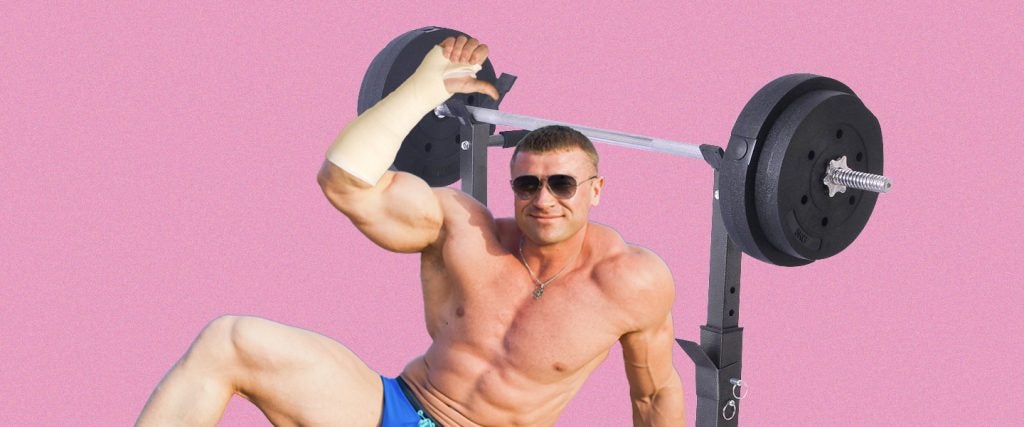The barbell-and-rack system debuted in the 1950s and made it possible to preload a weight bar with substantially more weight than a human could ever dream of being able to lift into an optimal chest-pressing position under ordinary circumstances.
But sadly, this meant that injuries resulting from attempts to lift such unprecedented weights also came to the fore. What’s worse, the problem has been exacerbated by the status conferred upon those with beefy bench-pressing sums on their resumes. Such a pursuit of strongman immortality has inevitably resulted in injuries — from mild to potentially fatal — incurred by even lifters who ought to know better.
Yet, that’s only one side of the equation. Sometimes the mistakes made aren’t inherently harmful, but they are the misguided byproduct of newbies being instructed incorrectly when they first began to train, or following one piece of advice to the point of absurdity.
What kind of mistakes am I talking about? Below is a brief list.
Lifting with Your Ego
If the goal is to optimally fatigue your chest in a manner that’s going to thoroughly and safely develop it, regularly attempting to exhibit your power through one-rep maximum lifts shouldn’t be part of your strategy. Allowing your ego to override your common sense has the potential to be a lethal mistake. Speaking of which…
Pushing Your Limits without a Spotter
Few other load-bearing movements place you in as much peril as barbell bench pressing, especially when you’re ascending to weight levels that approach or exceed your body weight. The potential for a perilous outcome is compounded exponentially if you decide to test your limits while training solo. With this in mind, if you absolutely must train for single-rep power without a friend in sight, do not clasp the plates to the bar.
Benching with an Arched Back
I can hear the powerlifters and those who emulate them screaming at me through their screens. But here’s the absurdity of the matter: Powerlifters don’t bench with arched backs because it’s the best way to develop the totality of their chests; a curved back elevates the chest, enabling powerlifters to bench with the strongest, most powerful fibers in the chests, while also drastically reducing the range of motion required to touch the bar to the chest and press it back to the starting position. As a result, someone who opts to bench with a curved back because they think its optimal for development will train their lower chest fibers on a flat bench — and their middle chest fibers on the incline bench — without ever adequately targeting the uppermost portions of their chest, and all while repeatedly placing the spine in a precarious position.
Benching with a Flat Back
I know, I know, but the ideal position for training with the bench press isn’t with your chest completely flattened out either, but with your chest open and elevated. Before you even lift the bar off the rack, you should pin your shoulders back to stabilize your position and open up your chest. This will give you a far better base to lift from while still enabling you to target the most desirable portions of your pectorals.
Touching the Bar to Your Chest
Look, if your chest and arms are of a certain thickness and length respectively, and your body is positioned appropriately, you’ll be left with no alternative other than to touch the bar to your chest before pressing it back to its starting position. But if you have long arms and a narrow chest, it’s risky. When the bar lowers and the angle of your arms drops to inside of 90 degrees, not only are you lifting from a point of low leverage, you’re also placing your shoulders in a position of unnecessary vulnerability when there is no inherent benefit to lifting from this position.
Your Hand Positioning Is Too Wide
It’s true that the wider your hands are positioned on the bar, the more your chest muscles will be engaged. However, the barbell bench press isn’t exclusively a chest exercise — nor is it even necessarily the most efficient method for training the chest. In truth, the bench press heavily involves the triceps and the anterior deltoids, in the same way that the squat incorporates the quadriceps and glutes into its essential motion. Thus, using a wide grip will focus on the chest, but it will nullify the involvement of a critical contributor to the lift.
Your Hand Positioning Is Too Narrow
Yes, it’s a tremendous idea to ensure that your triceps are contributing to the force behind the bench press, but it’s equally possible to have too much of a good thing. Moving your hands too far inward on the bar is going to do two things: First, it will transfer more of the burden onto your triceps, negating a larger portion of the chest’s function in the movement and preventing you from lifting as much as you possibly could. And second, it’s even more likely to result in your arms falling into a tenuous angle that places your shoulders at risk of a tear.
The good news is, the bulk of these mistakes can be corrected by focusing on one key point: To lift a quantity of weight in the manner most conducive to the building of muscle. In the end, that’s the real test of strength.

